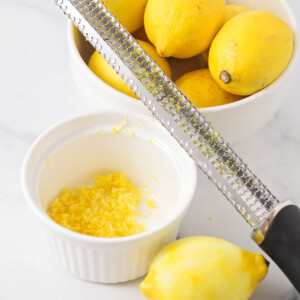This post may contain affiliate links. Please read our disclosure policy.
If you need to know how to zest a lemon, we have you covered! Plus we’ve rounded up plenty of zesting tips and tricks.
There are plenty of delicious sweet and savory recipes that require the zest of a lemon, like our tasty Lemon Zucchini Bread! For tips on how to zest a lemon check out the info below!

What is Zest?
You may have seen a recipe asking for “the zest of 1 lemon” or “1 teaspoon of lime zest”. Those new to cooking may wonder what exactly is zest, how to get the zest of a lemon, and why is it used.
You can zest most citrus fruits, such as lemons, oranges, and limes. Zesting a citrus fruit involves scraping off the outer layer of the peel, which contains the most essential oils and concentrated flavor.
The fine flavorful shavings are then used to add a burst of citrusy flavor to both sweet desserts and savory main meals, soups, salads, and more.

How to Get the Zest of A Lemon
Use these easy steps when zesting a lemon!
PREP. Wash and dry the citrus. Hold it firmly in one hand.
ZEST. In the other hand use the zesting tool to scrape the outer layer of the peel. Once you reach the white part, turn the fruit and continue scraping.
Turn and scrape the peel until you have enough zest for the recipe or until there is no more peel left.
Storing Extra Zest
Zest is best when used right away, but you can freeze it for later use. Keep the zest in an airtight container in the freezer for up to 6 months. Do not store zest in the refrigerator.

Zesting Tips
When zesting fruit, keep the following tips in mind:
- Use fresh citrus, free of blemishes and soft spots.
- If the citrus has a wax coating it can be removed by placing the citrus in a colander and pouring a pot of boiling water over the top. Use a vegetable brush to remove the coating. Rinse and dry them. (Organic lemons, limes, and other fruits do not generally have a wax coating).
- Ensure that the fruit is washed thoroughly and dried properly to remove any dirt or residue.
- Apply gentle pressure when zesting to scrape off only the colored part of the peel. Avoid digging too deep into the bitter white pith, as it can negatively impact the taste.
- As you zest, rotate the fruit gently to ensure that you only remove the colored part and not go too deep.
- Zest the citrus fruit until you have enough for your recipe. Adding too much zest to the recipe can lead to a bitter taste overpowering your dish.
- Some recipes often call for citrus juice I recommend that you zest the peel before cutting open the fruit.

Zest Substitute
I’m going to use a lemon as an example but it applies to other citrus as well. If you do not have access to fresh lemons to make zest you can try using one of the following alternatives:
- Replace the lemon zest with orange or lime zest.
- Lemon extract is a concentrated form of lemon flavor. It can be used sparingly as a substitute for zest, but be cautious as it is more potent. Start with a small amount and adjust to taste.
- Lemon juice won’t provide the same texture as zest, but it can still impart a hint of citrus flavor to your recipe. Keep in mind that it may add more liquid to the dish, so adjust the other ingredients accordingly.


Other Zesting Methods
If you do not have a citrus zester and come across a recipe calling for zest there are a few other alternative methods to make lemon zest:
- A microplane is a kitchen tool designed to remove the peel in long thin strips. These strips make a beautiful garnish for the dish you are preparing.
- The small side of a box cheese grater can be used.
- A vegetable peeler/potato peeler or sharp paring knife can be used to remove the outer layer of the peel. Use a kitchen knife and cutting board to then chop the peels into small pieces.
For Sweet Desserts Using Zest, Check Out:

Recipe FAQ
Zest is more potent and a little goes a long way. It also does not add any extra liquid to the recipe.
While citrus fruits like lemons, limes, oranges, and grapefruits are the most commonly used for zesting, you can also zest other fruits like apples and strawberries. Just keep in mind that the intensity and flavor of the zest may vary, so it’s always best to experiment and adjust according to your taste preferences and the specific recipe.
The size of the citrus and the method used both factor into the amount of citrus zest that can be produced. In general a medium-sized lemon or lime can produce about 1 tablespoon of zest while a medium orange can produce about 1½ tablespoons of orange zest.
For Savory Dishes Using Zest, Check Out:
- Orange Chicken
- BBQ Meatballs
- Lemon Rice
- Strawberry Salsa
- Smothered Pork Chops
- Pork and Broccoli Stir Fry

How to Zest a Lemon
Ingredients
- 1 lemon
Instructions
- Wash and dry the citrus. Hold it firmly in one hand.
- In the other hand use the zesting tool to scrape the outer layer of the peel. Once you reach the white part, turn the fruit and continue scraping.
- Turn and scrape the peel until you have enough zest for the recipe or until there is no more peel left.
Video
Nutrition
Nutrition information is automatically calculated, so should only be used as an approximation.










